A Gap in the history of gunpowder and cannon
In some documented histories of warfare and weapons in the Middle Ages and the Renaissance there is a noticeable gap in the history of gunpowder and cannon in the thirteenth and fourteenth centuries. Some Authors jump from China in the far east to Europe in the far west with the slightest reference or no reference at all to the Arabic and Islamic lands that spanned the whole distance between east and west. In the thirteenth century, technology could hardly have been transferred between the two extremities of the old world unless it passed through the Arabic and Islamic medium and subjected to more developments.
For some of the key Arabic words in this article, please see here.
It is not our purpose in this paper to review the history of gunpowder and cannon in China and Europe. We shall revisit some Arabic sources that were known and repeatedly discussed since the middle of the nineteenth century, and shall add few more manuscripts and sources that were not discussed before[1]. We shall analyse gunpowder composition for rockets and cannon as they are given in these manuscripts, and shall discuss briefly the development of cannon in the thirteenth and fourteenth centuries in the Mamluk Kingdom and in Muslim Spain. We conclude with a brief note about fireworks.
Potassium nitrate
In a recent paper[2] it was shown that Arabic alchemists knew potassium nitrate since the start of Arabic alchemy at the time of Khalid ibn Yazid (d. c. 709). It was known under various names, was used as a flux in metallurgical operations and for producing nitric acid and aqua regia. Recipes for these uses are found in the works of Jabir ibn Hayyan (Geber, d. 815), Abu Bakr al-Razi (Rhazes, d.932) and other alchemists.
Throughout the centuries potassium nitrates in Arabic was known by a variety of names, and the most important of these was natrun. It was called also: buraq; al-shiha that is found at the feet of walls; milh al-ha’it (wall salt); flowers of asyus stone; salt of asyus stone; salt of stone; shura; shuraj; suraj; milh al-dabbaghin (tanners salt); shabb Yamani and lastly barud.
Purification of potassium nitrates
Before potassium nitrate can be used effectively in gunpowder it should be purified. Two processes are found in Arabic literature:
1- The process of Ibn Bakhtawayh (early 11th Century)
Ibn Bakhtawayh, the physician, in his book Al-Muqaddimat (composed in 420/1029), described the freezing of water at any season by using potassium nitrate calling it shabb Yamani (Yamani alum). (See the article on potassium nitrates in this Web site).
2- The process of Hasan al-Rammah (13th Century)
Hasan al-Rammah describes in his book al-furusiyya wa al-manasib al-harbiyya (The Book of Military Horsemanship and Ingenious War Devices) [3] a complete process for the purification of potassium nitrate. This same process became a standard one in Arabic sources and we find it in various military treatises. It runs as follow:
“Take from white, clean and bright (or fiery) barud (saltpetre) as much as you like and two new (earthen) jars. Put the saltpetre into one of them and add water to submerge it. Put the jar on a gentle fire until it gets warm. Skim off the scum that rises (and) throw it away. Make the fire stronger until the liquid becomes quite clear. Then pour the clear liquid into the other jar in such a way that no sediment or scum remains attached to it. Place this jar on a low fire until the contents begin to coagulate. Then take it off the fire and grind it finely.” [4]
The procedure is further continued using wood ashes, which would precipitate calcium and magnesium salts:
“Take dry willow wood, burn it, bury it (smother it) as is with the harraq (tinder). Take by weight two thirds of saltpetre and one third of ashes of wood, which has been carefully pulverized, and put the mixture into the jar, and if the jar is made from copper so much the better. Add a little quantity of water and apply heat until the ashes and saltpetre no longer adhere together. Beware of sparks”
In this method calcium salts are removed by adding potassium carbonate in the form of wood ashes. Thus calcium carbonates are precipitated and can be removed leaving the chemically equivalent amount of potassium nitrate in solution. Saltpetre is obtained from this solution by crystallization.
The method of al-Rammah is the first in which wood ashes were used in the manufacture of saltpetre. Partington says that “the claim that Roger Bacon used wood ashes is based on an arbitrary manipulation of a text, and the first clear account of the process known to me is that of al-Hasan al-Rammah.” [5]
Use of potassium nitrates during the Crusades:
A subject that is still in its initial stages of investigation is the early use of potassium nitrate during the Crusades. There are advocates of the theory that potassium nitrates were used as a component of Greek fire whether Byzantine or Arabic.[6] We shall mention here few cases that suggest the use of nitrates by the Arabs during the time of the Crusades.
a- In the year 564 H/1168 AD the Firanja (the Franks or the Crusaders) besieged al-Fustat (old Cairo). Shawar[7] decided to burn the city. Al-Maqrizi says that 20000 pieces of karaz shami (ceramic Damascus grenades) full of incendiary materials were used. Al-Fustat continued burning for 54 days.[8] Mercier obtained several grenades from the site and their contents were analysed. The tests proved the existence of potassium nitrates.[9]
b- A military treatise that discusses military fires on a large scale is entitled Treatise on Stratagems in Wars, the Capture of Towns, and the Defence of Passes.[10] This gives a large number of Greek fire recipes. It describes Islamic military technology during the twelfth century. In one recipe natrun is one of the combustible ingredients.[11]
c-During the fifth Crusade that was directed against Egypt, Damietta was besieged in 1218 and the besieged used Greek fire extensively in their defences. Lalanne believes that the Arabic jars of fire contained potassium nitrates.[12]
d- The seventh Crusade was directed against Egypt also. Louis IX led a well-prepared invasion and occupied Damietta in 1249. By this time gunpowder was known in Syria and Egypt and in the battle of al-Mansura in 1250, in which Louis IX was taken prisoner, the use of large pots full of gunpowder and other combustibles was the key in the victory of the Arab Army. Joinville who was an officer and an eyewitness of the battle described eloquently these projectiles and their effect on the Frankish army. His description left no doubt among some historians that he was describing projectiles containing gunpowder.[13] In their history of rockets published on the internet NASA says “the Arabs adopted the rocket into their own arms inventory and, during the Seventh Crusade, used them against the French Army of King Louis IX “ [14]
e. Gunpowder was used extensively in 1291 at the very end of the Crusades during the siege of Acre, in which the city capitulated. The extensive mining of the city walls by gunpowder was described by Western historians. Military fires using gunpowder were projected by a large number of manjaniqs (trebuchets), and huge amounts of arrows carrying gunpowder devices were thrown by archers. Thousands of engineers were reported to have participated in the siege.[15]
Gunpowder composition of al-Rammah’s rockets (1280 AD)
Al-Rammah (d 695 AH/1295 AD) deals extensively in his book with gunpowder and its uses .The estimated date of writing this book is between 1270 and 1280. The front page states that the book was written as "instructions by the eminent master Najm al-Din Hasan Al-Rammah, as handed down to him by his father and his forefathers, the masters in this art and by those contemporary elders and masters who befriended them, may God be pleased with them all ". It is unmistakable from this statement that Al-Rammah compiled the inherited knowledge. The large number of gunpowder recipes and the extensive types of weaponry using gunpowder indicate that this information cannot be the invention of a single person, and this supports the statement of the front piece in his book. If we go back only to his grandfather's generation, as the first of his forefathers, then we end up at the end of the twelfth century or the beginning of the thirteenth as the date when gunpowder became prevalent in Syria and Egypt.
The book contains 107 recipes for gunpowder.[16] There are 22 recipes for rockets (tayyarat, sing. tayyar). Among the remaining compositions some are for military uses and some are for fireworks. The gunpowder composition of seventeen rockets is shown in the following table. Five rockets are not included because their ingredients included other materials. We limited ourselves for the sake of comparison to the three main ingredients.
Gunpowder Composition for 17 Rockets from al-Rammah (1280 AD)
No.
|
Descrption
|
KNO3
|
S
|
C
|
18a
|
Tayyar
(rocket)
|
10
69
|
1.5
10.33
|
3
20.67
|
19a
|
Tayyar
(rocket)
|
10
74.77
|
1.125
8.41
|
3.25
16.82
|
21a
|
Tayyar
(rocket)
|
10
76.92
|
1
7.70
|
2
15.38
|
22a
|
Tayyar
(rocket)
|
10
74.07
|
1.25
9.26
|
2.25
16.67
|
23a
|
Tayyar
(rocket)
|
10
75.95
|
1.083
8.23
|
2.083
15.82
|
25a
|
Tayyar
(rocket)
|
10
71.43
|
1.5
10.71
|
2.5
17.86
|
26a
|
Tayyar mujarrab
(tested rocket)
|
10
75.47
|
1.625
12.27
|
1.625
12.26
|
28a
|
Tayyar muqdah
(roast rocket)
|
10
71.43
|
1
7.14
|
3
21.43
|
1b
|
Tayyar Majnun
(mad rocket)- lifts
I Dam. ratl + 7.5
Ouqiyya =2.13 kg
|
12
74.42
|
1.375
8.53
|
2.75
17.05
|
2b
|
Tayyar (rocket),
lifts 1 Dam. Ratl
= 1.85 kg
|
9
83.72
|
0.875
8.14
|
0.875
8.14
|
3b
|
Tayyar Tunsi
(Tunisian rocket)
|
11
73.33
|
1.25
8.34
|
2.75
18.33
|
4b
|
Tayyar sakran
( drunk rocket)
|
10
76.93
|
1.125
8.64
|
1.875
14.43
|
5b
|
Tayyar buruq
(lightning rocket)
|
10
74.07
|
1.375
10.19
|
2.125
15.74
|
6b
|
White tayyar
(rocket) without
sparks
|
10
74.07
|
1.25
9.26
|
2.25
16.67
|
34b
|
Heavy tayyar
(rocket)
lifts 1.25 Dam. Ratl
= 2.313 kg
|
12
68.57
|
1.75
10
|
3.75
21.43
|
36b
|
Tayyar
(rocket) for arrows
|
12
88.07
|
1
7.34
|
0.625
4.59
|
Average for 17
rockets
|
75
|
9.03
|
15.97
|
Notes: Series (a) are the main gunpowder formulations of al-Rammah. They are 65 in number and occur on pp. 70-77 of the published Arabic text. Series (b) are the second series of formulations. They are 42 in number and occur in pages 131-137. First line is in dirhams and second line shows percentages.
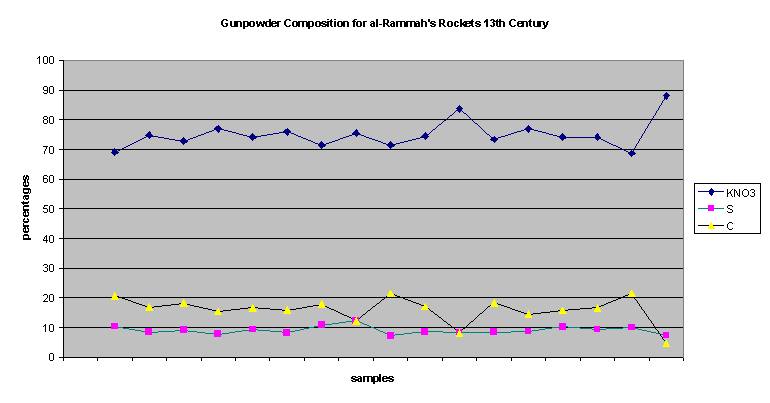
If we look at the table and the graph, we notice that most ratios fall around the median lines with few odd points only. The median value for potassium nitrates is 75 percent. The minimum odd value is 68.57 percent and the extreme odd one is 88.07
It is reported by Hall that most authorities regard 75 percent potassium nitrate, 10 percent sulphur, and 15 percent carbon to be the best recipe.[17] Al-Rammah’s median composition for 17 rockets is 75 nitrates, 9.06 sulphur and 15.94 carbon which is almost identical with the reported best recipe.
Gunpowder composition for rockets in funun al-naft of St. Petersburgh MS
We shall describe the St. Petersburgh manuscript in more detail when we discuss cannon. There is a chapter in this manuscript under the title ‘funun al-naft min al- jidd wa al-hazl’ (The art of gunpowder for serious work or for pleasure). It gives a list of gunpowder compositions for pleasure (fireworks) and for war including five compositions for rockets as shown below. [18]
Rockets from St. Petersburgh MS., early 14th Century
KNO3
|
S
|
C
| |
76.19
|
6.67
|
17.14
| |
74.07
|
7.14
|
18.52
| |
74.77
|
5.6
|
19.63
| |
75.47
|
5.66
|
18.87
| |
71.43
|
7.14
|
21.43
| |
Average
|
74.38
|
6.5
|
19.12
|
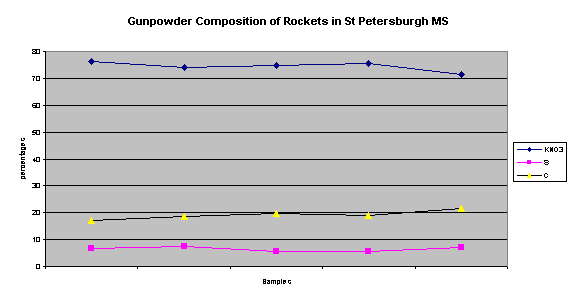
Gunpowder composition in al-Karshuni manuscript for miscellaneous military purposes 11th century
The Karshuni manuscript (written in Arabic with Syriac script), which belongs to the period ninth to eleventh century according to Berthelot and Duval[19], gives a few compositions of gunpowder. If we discount such an early date, then it is possible that these were later additions from the thirteenth century as was supposed by Lippmann. The following are the ones related to military uses.[20]
Gunpowder Composition in the Karshuni MS. 11th-12th Century
(Possibly 13th c additions)
KNO3
|
S
|
C
| |
71.43
|
10.71
|
17.86
| |
83.33
|
8.33
|
8.34
| |
71.53
|
14.23
|
14.28
| |
66.67
|
16.66
|
16.67
| |
68.97
|
10.34
|
20.69
| |
Average
|
72.37
|
12.06
|
15.57
|
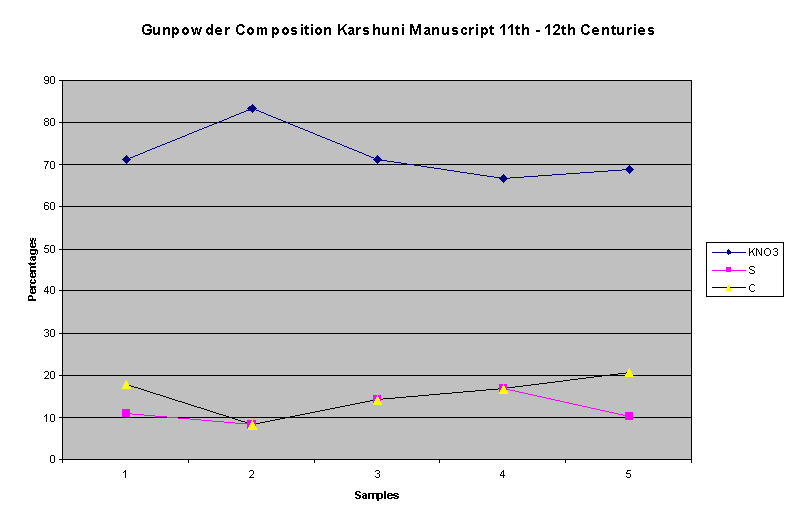
Gunpowder composition in Beshir Agha manuscript for rockets and other uses- 14th Century
This is a military treatise of unknown author and unknown date. From the text we infer that it was written in the first half of the fourteenth century. The author says the Franks are ignorant of the art of gunpowder and its uses and he warns in strong terms against revealing its secrets to them. This implies that the author was writing in the last days of the Crusades. The following are gunpowder recipes for rockets and other military uses: [21]
Beshir Agha MS
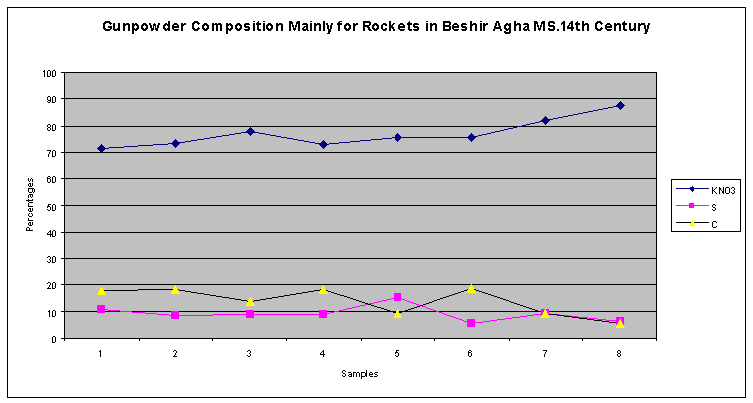 |
Gunpowder composition of rockets from `Iyarat al-naft manuscript 13th-14th centuries
This manuscript contains a large number of gunpowder recipes, totalling about 239. Its title is `Iyarat al-naft (Formulae of Gunpowder) [22]. Its author is not known but the copy that we consulted was copied in 774/1372; the original should be much earlier. Al-Rammah’s book was compiled in about 1270-80 and this one could be compiled on the first decades of the fourteenth century. It gives recipes for fireworks as well as for military purposes. We have selected all the rockets recipes that contain only the three main ingredients of gunpowder: [23]
Gunpowder Composition for Rockets from Iyarat al-naft MS, 14th Century
| |||
KNO3
|
S
|
C
| |
72.07
|
9.06
|
18.92
| |
71.43
|
11.93
|
16.64
| |
71.43
|
10.71
|
17.86
| |
74.08
|
11.11
|
14.81
| |
75.47
|
11.32
|
13.21
| |
71.43
|
10.71
|
17.86
| |
67.47
|
16.86
|
15.71
| |
74.77
|
6.54
|
18.69
| |
72.72
|
9.1
|
18.18
| |
74.07
|
5.56
|
20.37
| |
70.97
|
12.1
|
16.93
| |
71.43
|
12.5
|
16.07
| |
69.56
|
11.6
|
18.84
| |
Average
|
72.07
|
10.7
|
17.23
|
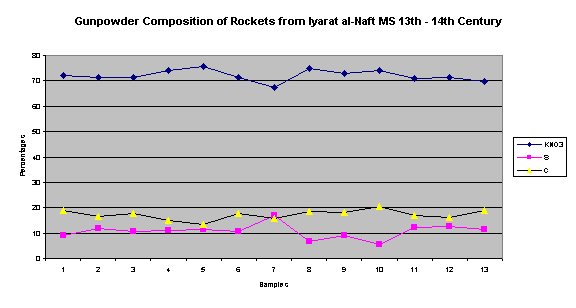
Gunpowder composition for the earliest cannon (13th to early 14th c)
Four Arabic treatises describe or mention small portable cannon.[24] All these treatises report that cannon were used in the battle of `Ayn Jalut in Palestine in 1260 between the Arab Army and the Mongols, in which the latter were defeated. It was used once more against the Mongols in 1304. The purpose of the early cannon and other gunpowder devices as we shall see was to frighten the enemy’s horses and cavalry and cause disorder in their ranks. The St. Petersbugh MS is the most renowned among the four manuscripts. Renaud and Fave attributed it to Shams al-Din Muhammad. The only literary figure with this name at this period is Shams al-Din Muhammad al-Ansari al-Dimashqi (d.1327) who, like al-Rammah, was from Damascus, and both were contemporaries. Al-Dimashqi is well known for his cosmography in which he described the use of fireworks in Hama in central Syria. [25] In the St. Petersburgh MS. the cannon is described as follows: [26]
“Description of the drug (dawa’) that you put in the cannon (midfa`)- Its composition (`iyaruhu) is: potassium nitrate (barud) ten, charcoal (fahm) two dirhams and sulphur (kibrit) one and a half dirhams. Grind it finely and fill one third of the cannon (midfa`). Do not fill more otherwise it will split. Then let the wood turner make a wooden plug (midfa`)[27] of the same size as the mouth of the cannon (midfa`). Ram (the gunpowder) tightly and place on it the ball (bunduqa) or the arrow, and give it fire at the ammunition (al-dhakhira). Measure the cannon (midfa`) at the hole; if it (i.e. the midfa`) is deeper than the hole then it is defective and it will punch the gunner (al-rami), so understand this.”
The composition of 10 dirhams of saltpetre, one and a half dirhams of sulphur and two dirhams of charcoal gives the percentages of 74.1 nitrates, 11.1 sulphur and 14.8 charcoal.
In the Istanbul manuscript the description is as follows: [28]
“The drug that you put in the cannon (midfa`): potassium nitrate (barud) ten, charcoal (fahm) two dirhams, sulphur (kibrit) one dirham. Grind finely, and fill one third of the cannon (midfa`), not more. Seal it (i.e. the gunpowder) by the device after you have rammed it; then place the ball (bunduq) or the arrow and give fire to the ammunition (al-dhakhira)”.
In these cannon the percentages of gunpowder are 77 nitrates, 7.7 sulphur and 15.3 charcoal.
We have another gunpowder composition for cannon in Kitab al-aniq[29] and a fourth one in Kitab`iyarat al-naft . The four compositions are listed together as follows:
| ||||||||||||||||||||||||||||||||||||
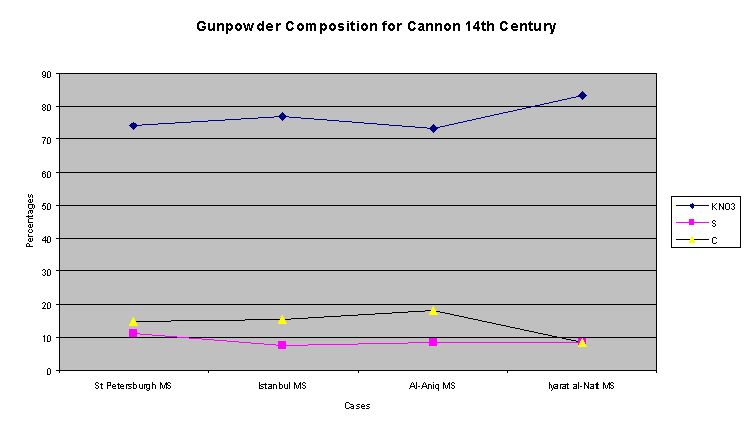
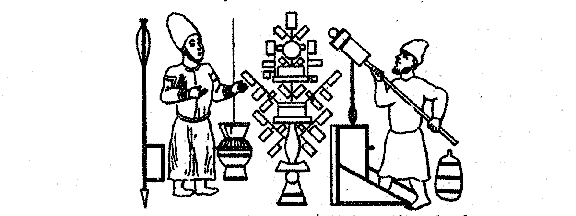
St. Petersburgh MS. p.156, Illustration of Khita’i arrows, rockets, military midfa`,
al-su`at(rockets that seek a destination) and gunpowder crackers.
In this illustration the midfa` (cannon) has a carrying stick.
We see also on the right what looks like a bomb or an incendiary jar.
Tactics of using the early cannon
The following text from St. Petersburgh manuscript describes the use of the early cannon along with other gunpowder devices in battle tactics:
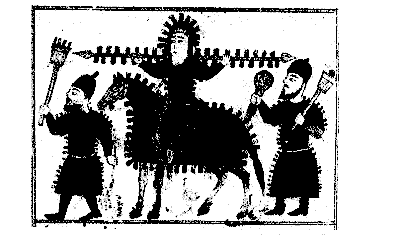
St. Petersburgh MS., p. 159, Illustration of the faris (knight) who frightens the horses of the enemy and the two foot soldiers accompanying him. On the right, the foot soldier is carrying a hand-held midfa` (cannon), and on the left the soldier is carrying a sprinkling club. The mounted knight carries a lance to which gunpowder cartridges are attached. The three men and the horse wear also fireproof clothing to which gunpowder cartridges are attached.
“The kings of old times did not engage in war except by stratagem. The Prophet said: war is trickery. This was the practice until the time of Halawun (Hulaku or Hulegu) when the people of Egypt used this trick and defeated the Tatars (Mongols). Horses (of the enemy) dare not face fire and the horse will run away with its rider. The way to do it is to choose a number of cavaliers and furnish their lances from both ends with gunpowder (barud [30]). The cavalier will wear a garment (qarqal) with its front face made of black thick woolen cloth (balas). It is strewn with balls of linen fiber (mushaqq) that have metal wires at their ends so that they are inserted into the garment and the helmet. The horse is also draped with thick woolen cloth (balas). His hands will be smeared with dissolved talc so that he is not burnt by fire. In front of them will be whatever they choose from foot soldiers furnished with sprinkler maces, crackers (sawarikh, explosive charges) and cannon (madafi`). They (the cavalrty and the foot soldiers) will take their place in front of the army.” [31]
More detailed description of the attire of the cavalier, the horse and the foot soldiers is given in the manuscript. There is a detailed description on how to train the horses to get them used to the loud explosive noise of the cannon and the gunpowder crackers. The method of conducting the attack to frighten the enemy’s horses and causing them to run away is also described.
This tactics of using the portable cannon continued throughout the century and was the precursor of portable firearms. Muhammad Ibn Mankali in one of his military treatises (written around 764-78/1362-70) [32]wrote:
“If the Franks who are facing us are cavalry then we shoot at them with incendiary arrows and cannon since their horses will be frightened away and when their mobilization is in disarray then they will be chased.”
The use of the portable cannon continued and it was used in celebrations in addition to its use in warfare. The French traveller, Bertrandon de la Brocquiere, visited the Holy Land in 1432 and wrote his book The Voyage d’Outremer. When he was in Damascus he saw the celebrations on the occasion of the return of pilgrims from Mecca after the hajj. He says:
“The day after my arrival I saw the caravan coming from Mecca. It was said that there were more than three thousand camels. The lord and all the notables of the city went out to meet the caravan.” [33]
“There were also at least thirty men around the mahmal camel, some carrying crossbows and others with unsheathed swords in their hands. Some had little cannon which they fired from time to time” [35]
The development of cannon in the fourteenth century in the Mamluk Kingdom (Syria and Egypt)
In 1340 AD, Ibn Fadl Allah al-`Umari wrote a handbook for government officials in which he described the main weapons that were used in the attack or the defence of towns. [36] He describes cannon that were used in the attack of walled cities. “They throw balls that batter the tops of parapets and break the columns of arches”. The cannon developed within four decades into a siege engine along with the trebuchet. It is reported by the historian Salih ibn Yahya that in 743/1342 the besieged in al-Karak mounted on its walls five trebuchets (manjaniqs) and many cannon.[37] It is also reported that in 753/1352 the governor of Damascus fortified greatly the citadel by mounting on it gunpowder cannon (al-makahil bi al-madafi`).[38]
Al-Qalqashandi described in his encyclopaedia, Subh al-a`sha, the prevailing siege engines in 767/1365. About cannon he says:
“Among them (i.e. the siege engines) is the gunpowder cannon (makahil al-barud). These are the cannon (madafi`) that use gunpowder. They are of different types. Some of them throw huge arrows that can almost pierce stones. And some throw iron balls weighing from ten Egyptian ratls ( about 4.53 kg) up to more than one hundred (45.3 kg). I saw in Alexandria during the Ashrafiyya State, (of Sultan) Sha`ban ibn Husayn[39], when Prince Salah al-Din ibn `Arram, God have mercy on him, was governor, I saw a cannon made of copper and lead and bound by iron ends. A huge heated iron ball was projected from it in the maydan (parade square or hippodrome), and it fell into the Silsila Sea outside Bab al-Bahr (Sea Gate), which is a faraway distance.” [40]
At this same period a military treatise called al-Aniq fi al-manajiq was written by Ibn Aranbugha al-Zaradkash. The author presented the book to the Atabik (chief commander of the army) Mankali Bugha al-Shamsi who was in office between 769/1367 and 774/1372. The following illustration shows cannon for shooting arrows, mounted on an adjustable stand for pointing the gun at various angles of projection[41]. The gunpowder composition for these cannon is ten dirhams of potassium nitrate, 1.125 sulphur, and 2.5 charcoals. This gives the percentages of 73.4 potassium nitrate, 8.26 sulphur and 18.34 charcoals.
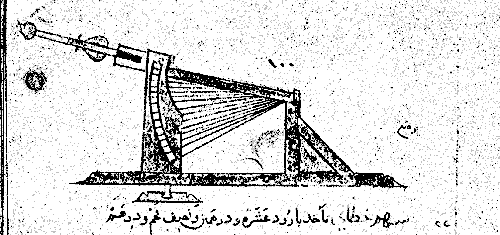
Development of cannon in al-Andalus and al-Maghrib in the 13th and 14th centuries
We have no extant Arabic military treatises left to us from al-Andalus and al-Maghrib regarding gunpowder. But since this symposium is taking place in Granada, the seat of the last Moorish kingdom in al-Andalus, it befits us to give a brief account of the history of cannon in this area. [42]
Reports about the use of cannon by the Arabs in Spain are given in the works of Spanish and Arab historians who were closer to the times of the events or even have witnessed them. When they wrote their accounts they did not have the same thinking that triggered the debate among historians of gunpowder and firearms of the 19th and the first decades of the 20th centuries. The question about the first nation to formulate propulsive gunpowder or to use cannon was irrelevant to them. In the last three decades of recent history some scholars adopted a more balanced attitude and started to free themselves from the euro centric way of looking at historical sources. In this brief survey, we shall present the primary reports about the main events without trying to confuse the reader with the disputations of the past two centuries.
Most of the argument arose when some historians tried to interpret the Arabic word naft to denote naphtha or a mixture of incendiary ingredients containing naphtha. A study of the titles of treatises dealing with gunpowder composition given in this article will make it clear that naft denoted in fact gunpowder. The term naft was used originally for military fires of any composition, and as soon as the new mixture of saltpeter-sulphur-charcoal was known, the word naft was applied to it. So the treatise of `Iyarat al-naft mentioned above means Formulations of Gunpowder as we have seen.
In the Vocabulista (a Latin-Spanish Arabic vocabulary compiled in the region of Valencia, in the 13th century), one finds the word naft opposite Ignis and Ignem excutere. In the later historical accounts this word denoted gunpowder. In al-Andalus in the course of the second half of the 15th century, gunpowder became barud, and saltpetre became milh al-barud. Naft (pl. anfat) then denoted cannon, and naffat denoted gunner. [43]
When we discuss the development of gunpowder and cannon in al-Andalus and al-Maghrib countries, we must take into account their parallel development in the Arab east namely in the Mamluk Kingdom.
Another factor that is relevant to our study is the fact that potassium nitrates were abundant in Muslim Spain, and it was the only country in Europe having these natural deposits.[44] Watson says in his Chemical Essays: “The lands of Spain, says the author of its Natural History, if properly managed, would supply all Europe with saltpetre to the end of the world.” [45]
The Arabs are reported to have used rockets on the Iberian Peninsula in 1249; and in 1288 rockets attacked Valencia.[46] This report needs to be investigated further in order to determine the sources of information.
Peter, Bishop of Leon, reported the use of cannon by the Arabs while defending Seville in 646 AH/ 1248 AD. [47] Ferdinand III harassed Seville increasingly and kept the town under siege for 17 months until it surrendered. [48] At this same time, in the Mamluk Kingdom, gunpowder was already in use in warfare during the Crusades, and if the devices used in Seville were not cannon, then they were most probably projectiles utilizing gunpowder similar to those used by the Mamluks in the battle of al-Mansura in 1250 against Louis IX.
In 660 / 1262, King Alfonso X of Castile succeeded in conquering the city of Niebla. The siege was not easy either for the besiegers or for the Muslim inhabitants due to the strength of the town’s defences, so the siege lasted nine months and a half. It is reported that Almohads in defending the city used machines that resembled cannon, which projected stones and fire accompanied by thundering noises. Some Spanish histories consider that this was the first time that gunpowder had been used in warfare in Spain.[49]
Ibn Khaldun (8th/14th century) says that the Marinid Sultan Abu Yusuf Ya`qub, when besieging the town of Sijilmasa in 672-3/1274:
“Brought into action against this town mangonels (majaniq) and ballistas (`arradat), as well as a naft engine (hindam al-naft i.e. gunpowder cannon) which discharged small iron balls (hasa al-hadid). These balls are ejected from a chamber (khizana) placed in front of a kindling fire of gunpowder. This happens by a strange property which attributes all actions to the power of the Creator.” [50]
This precise information about the use of cannon came from a great historian. However, western historians of firearms in the nineteenth and the first part of the twentieth centuries questioned the report of Ibn Kaldun. Historians in those days were bound by certain fixed historical dates for gunpowder and cannon that could not be changed even if they go to the extreme of discrediting a historian of the calibre of Ibn Khaldun. We have seen above that portable cannon were used by the Mamluks in 1260 in the battle of `Ayn Jalut. Indeed, we would advance the view that in the Maghrib and al-Andalus, where petroleum was not available whereas potassium nitrate was known to be abundant, cannon may have developed into a siege engine somewhat earlier than in the Islamic East, and that the appearance of cannon at Sijilmasa as described by Ibn Khaldun was a natural development the veracity of which need not be doubted.
In the fourteenth century, the historic accounts regarding the use of cannon by the Moorish kings of Granada, in defensive as well as offensive operations had caused considerable debate among western historians in the nineteenth and the first decades of the twentieth centuries. After reviewing the position of some military historians in Europe, Ada Bruhn de Hoffmeyer in her carefully focused survey, Arms and Amour in Spain, concludes that:
“The old theories about the Arabs and the Moors and their importance in regard to gunpowder and early artillery in the 14th century cannot be rejected---on the contrary! Alchemy and chemical experiments flourished among the Arabs in the Mediterranean world not least in Moslem Andalusia, and Saracen scientists and technicians were working at various courts of occidental Europe.”
“The general opinion no doubt must be that gunpowder artillery was introduced rather early to Spain through the Arabs via the Moors of Maroc and from them to Moslem Andalusia. From the Hispano-Moors Christian Spain learned about gunpowder artillery. The routes probably passed via the Granadine kingdom, which at that time had very close contacts with the sultan of Maroc in Fez, from which place Granada got military help against the Christians. Italy is represented with the Genoese navy supporting Granadines and Moroccanes.” [51]
The facts depend upon the correct translation of certain words from Arabic manuscripts. Hoffmeyer refers to the work of Kohler when she says:
“It is not impossible that G. Kohler in his work: Die Entwicklung des Kriegswesens und der Kriegsfiihrung, Breslau 1887, was right in his suppositions that the Arabs rather early introduced not only gunpowder but even fire-arms to Spain, from whence they passed to Italy (coincidence with the documentation from Florence) and from Spain and Italy to France and Germany. (The routes from Hispano- Moorish Andalusia, passing through Murcia, the Levantine coasts of Spain, Aragon to Italy is nothing strange in the 14th century, when the Mediterranean was a «Mar Aragones».) “ [52]
The main incidents we are concerned with in the following account had taken place during the tenure of Sultan Abu al-Walid Isma`il ibn Nasr (713 AH/ 1314 AD-725 AH/1325 AD), the Nasrid king of Granada who waged a number of successful campaigns between the years 1324 and 1325. In 724/1324 he besieged the fort city of Huescar using cannon in his siege, of which Lisan al-Din ibn al-Khatib (1313-1374) who was a youth at the time, and who became later a minister in Granada, relates:
“He headed towards the enemy territory and challenged the fort of Huescar that stands as a bone in the throat of Baza, which he besieged and attacked. He struck the arch of the invincible tower with a red-hot iron ball bombarded by the great engine that operates by naft (gunpowder). “ [53]
To celebrate the occasion, the scientist and poet, Abu Zakariyya Yahya ibn Hudhayl [54] whom Ibn al-Khatib highly praised, being his teacher, had composed a poem complementing the sultan for the conquest of Huescar:
"They thought that the thunder and the lightning had come down from the skies; whereas the thunder and lightning are all around them being created by man.
These are things of wondrous shapes, sent high by Hermes[55] and engineered to demolish mountains when they hit.
Yes, it is this world that always shows you miracles, since nature’s innate powers are destined to appear “
Based on the reports of these eyewitnesses McJoynt concludes that:
“Granada must have been in the forefront of technical innovation in the world at this time. The new weapon was a success, for Huescar hastened to surrender”.[56]
Lomax concludes also that “The capture of Huescar had seen the first use of gunpowder and cannon in European warfare.” [57]
After the conquest of Huescar, Sultan Isma`il waged a number of campaigns in which he captured a number of cities and forts including Baza and Martos in which he used cannon also.
In 732 /1331 Sultan Muhammad IV laid siege to the city of Alicante, of which the Spanish historian Zurita (1512-1580) maintains that “when the Moorish king of Granada besieged Alicante he used a new machine that caused great terror. It threw iron balls with fire.” [58] Hoffmeyer finds the report of Muslim gunpowder weapons at Alicante to be “difficult to deny”, given obvious awareness of such weapons at the time.
In a confrontation, known as the battle of Tarifa or the battle of Rio Salado in 1340, the Arabs lost heavily to the Castillian armies and their allies. The Spanish historian Conde relates that in the battle of Tarifa the Arabs had employed machines of thunder that launched iron balls propelled by nafta, causing extensive damage to the towers and the fortifications of the city.[59]
However, the main objective of the Spaniards was to occupy and hold on to the strategic port city of Algeciras (al-Jazira), situated next to the straight of Gibraltar. They had engaged the aid of their allies in Europe in a crusade against the Arabs, to which France and England were among respondents by sending army contingents. The siege of the city lasted twenty months, from 1342 to 1344, during which time the Arabs defended the city courageously, using cannon profusely and engaging the enemy in daring encounters.
The Spanish historian Juan de Mariana (1536-1623) described the use of gunpowder and cannons during the capture of Algeciras. [60] He states:
“The besieged did great harm among the Christians with iron bullets they shot. This is the first time we find any mention of gunpowder and ball in our histories.”
De Mariana also relates that the English Earl of Derby and Earl of Salisbury had both participated in this siege. Richard Watson[61] thinks that the two earls had conceivably transferred the knowledge about cannon and gunpowder and their use as effective firearms to England, and that the English adopted this new weapon and used it in the battle of Crecy in 1346. Furthermore, Prescott in his book Ferdinand and Isabella [62] emphasizes that the Spaniards had adopted their knowledge of gunpowder from the Arabs of Granada who were familiar with its utilization for a considerable time before their encounter with the Spanish in this siege. Ada Bruhn Hoffmeyer finds it “fully trustworthy” that King Alfonso XI of Castile and the Muslims used “gunpowder as propulsor for projectiles” at Algeciras in 1342.[63]
The use of gunpowder and cannon spread quickly in Spain. The Spanish kings at the initial stages enlisted the help of Moorish experts. Hoffmeyer says:
“The first artillery-masters on the Peninsula probably were Moors in Christian service. The king of Navarra had a Moor in his service in 1367 as «maestro de las guarniciones de artilleria. The Morisques of Tudela at that time had fame for their capacity in reparaciones de artilleria.” [64]
Fireworks, a brief note
The use of gunpowder in fireworks in festivities by the public in the Arab cities took place at the same time as it was used for military purposes. This is evident from the titles of treatises giving the composition of gunpowder. The majority of recipes given in the thirteenth century by al-Rammah and in the Karshuni manuscript are for fireworks. Similarly the gunpowder treatises of the fourteenth century deal mostly with fireworks. There are a very large number of recipes for fireworks. The names of the different kinds fireworks are varied to a large extent and this will be the subject of a separate study.
Reports about the use of fireworks in Arab cities can be found in non-military treatises. Al-Dimashqi (d. 1327) who was contemporary with al-Rammah describes in his cosmography (written second half of 13th century) the joint use of fireworks by the Muslims and Christians of Hama in central Syria on the eve of the birthday of Jesus.[65]
In a book on various trades and crafts, that was not noticed until recently, dating from the same period of al-Rammah and al-Dimashqi, we find a description of a gunpowder cracker and a gunpowder fireworks device. This book was compiled by King al-Muzaffar Yusuf ibn `Umar ibn Rasul (d. 694/1294) of Yemen. The title of the book is al-Mukhtara` fi funun min al-suna` (Inventions from the Various Industrial Arts). The description of the gunpowder cracker runs thus:
“Description of a furqa`a (cracker): fold a sheet of paper four or five folds on a mould. The mould is a rod that is turned to the thickness of a finger. Fold it very tightly, five or six plies. Take it off the mould. Seal its head very tightly, and fill it with barud and the charcoal of willow tree mixed together, and close its end very securely. If you want to give it fire pierce the head with a small piercing iron and insert a fuse that has been twisted very well. Glue the fuse to the hole, give it fire and move away. It will crack and move with explosive noise.” [66]
The use of fireworks by the Mamluk sultans in public celebrations in the fourteenth century and later is reported in the history books of that period.[67] Fireworks were called in these reports harraqat al- naft or harraqat al-barud.
When the French traveller Bertrandon de la Brocquiere arrived in Beirut in 1432 the inhabitants were celebrating the `Id. He was surprised to see the fireworks for the first time. He says:
“The Moors held a celebration, which is, I understand, an old custom. It started at nightfall. There was a great crowd of people singing and shouting. The men of the castle shot off the cannon and those of the city shot some kind of fire very high and very far. It was bigger than the biggest lantern I have ever seen. They say that they use it sometimes on the sea, against enemies to burn the sails of a ship. It would easily burn a house or a town with straw roofs, it seems to me. In a cavalry engagement it would terrify the horses. It is easy and cheap for someone who knows what they are doing. “ [68]
We infer from his story that fireworks were un-known in France at that time (in 1432). Brocquiere says then that he was able, against a bribe, to learn the secret of these fires and he took the information with him to France.[69] The first recorded fireworks in England were at the wedding of Henry VII in 1486. They became very popular during the reign of Queen Elizabeth I.
The people of Granada and other cities in al-Andalus used fireworks in their celebrations,[70] as was the custom in the cities of Syria and Egypt.
Arabic Manuscripts and References:
- Beshir Agha MS No. 441, Istanbul, Risala fi jarr al-athqal wa ghayriha min al-`aja’ib, unknown author.
- al-Dimashqi, Shams al-Din Muhammad al-Ansari, Nukhbat al-dahr, edited by Mehren, Leipzig, 1923.
- Enan, Muhammad Abdulla, al-athar al-andalusiyya al-baqiya, Cairo, 1961.
- Al-Hiyal fi-al-hurub wa fath al mada’in wa hifz al durub, ms. Ahmet III, Serai No. 3469, Istanbul, author uncertain. Several other manuscripts of this treatise exist in Istanbul, Leiden, and Ribat. Sulayman al- Rahili, Saudi Arabia, published this MS in 1418/1997. He attributed it by error to Ibn Mankali..
- Ibn Abi Usaybi`a, `Uyun al-Anba’ fi tabaqat al atibba’, ed. Nizar Rida, Beirut, 1965
- Ibn Aranbugha al-Zaradkash, al-aniq fi al-manajiq, ed. Ihsan Hindi, Aleppo, 1985.
- Ibn Iyas, Muhammad ibn Ahmad, al-mukhtar min bada’i` al-zuhur,vol. I, Cairo,1960.
- Ibn Khaldun, Kitab al-`ibar ..., vol. VII, Beirut, 1971.
- Ibn al-Khatib, Lisan al-Din, al-ihata fi akhbar ghirnata, vol, I, Cairo, 1319/1901.
- Ibn Mankali, Muhammad, al-adilla al-rasmiyya li al-ta`abi al-harbiyya, Istabul, Aya Sophia MS 2875. It was edited by Mahmud Shith Kattab, and published by the Iraqi Academy, Baghdad, 1988.
- Ibn Yahya, Salih, Tarikh Bayrut, ed. Kamal Salibi, Beirut, 1969.
- Istanbul MS. Revan Koshku 1933.
- `iyarat al-naft part of a collection of manuscripts (majmu`a) under the title of al-aniq, Ahmet III 3469, Istanbul, pages 94-132.
- Al-Maqqari, Ahmad ibn Muhammad, Nafh al-tib min ghusn al-andalus al-ratib, Bulaq, 1279/1862
- Al-Maqrizi, Al-Mawa`iz wa al-‘i`tibar, vol. I, Cairo, n.d.
- Paris Arabe 2826, Kitab al-makhzun li arbab al-funun
- Paris Arabe 2824, Kitsab al-makhzun jami` al-funun
- al-Qalqashandi, Ahmad ibn `Ali, Subh al-a`sha, vol. II, Cairo, 1963.
- Al-Rammah, Najm al-Din Hasan, Al-Furusiyya wa al-manasib al-harbiyya, edited with analytical introductory chapters by Ahmad Y. al-Hassan, Aleppo, 1998
- Rasul, al-Malik al-Muzaffar Yusuf ibn `Umar ibn `Ali ibn , al-mukhtara` fi funun min al-suna`, ed. Muhammad Isa Salhiyyeh, Kuwait, 1989.
- St. Petersburgh MS. Al-Makhzun jami` al-funun, uncertain author.
- al-`Umari ibn Fadl Allah, al-Ta`rif bi al-mustalah al-sharif, Cairo, 1312/1894.
Non-Arabic References
Atiya, Aziz S., Crusade, Commerce and Culture, Indiana University Press, 1962.
Berthelot, M. and R. Duval, La Chimie au Moyen Age, vol. II, Paris, 1893.
Conde J A, History of the Dominion of the Arabs in Spain, translated by Mrs Jonathon Foster.3 volumes, London:, 1855
Brocquiere, Bertrandon de la, [Le] voyage d'Outremer, publ. et annote par Ch. Schefer, Paris : E. Leroux, 1892.Reproduced at Gallica web pages of Bibliothèque nationale de France, 2001. This book was translated into English by Galen R. Kline, New York, 1988.
Dozy, R., Supplement aux dictionnares Arabes, vol. II, reprinted by Libraire du Liban, 1968.
Hall, Bert S., Weapons, Warfare in Renaissance Europe, John Hopkins University Press, 1997.
Al-Hassan, Ahmad Y., Potassium Nitrate in Arabic and Latin Sources, paper presented to the XXI International Congress for the History of Science, Mexico City, 2001. (Proceedings are under publication). See this paper on the present Web site.
Joinville, The Life of Saint Louis, in Joinville and Villehardouin, Chronicle of the Crusades, Penguin, 1963.
Lalanne, L., Recherches sur Ie feu gregeois et sur l’introduction de la poudre a canon en Europe, Paris, 1845.
Lomax, Derek W., The Reconquest of Spain, London, 1978.
Mariana,.Juan de, Historia general de Espana, 2 vols., Madrid, 1608, ii, 27; English tr. by Capt. John Stephens, The General History of Spain, 2 pts., London, 1699.
Mercier, Maurice, Le Feu Greg/ois. Les Feu a Guerre depuis l'Antiquiti. La Poudre a Canon, Paris, 1952
Partington, J. R., A History of Greek Fire and Gunpowder, reprint by John Hopkins University Press,
Prescott, William H., History of the Reign of Ferdinand and Isabella, ed. John Foster Kirk, 3 volumes, Philadelphia, 1880.
Prescott, William H., The Art of War in Spain- The Conquest of Granada, edited by Albert D. McJoynt, London, 1995.
Reinaud , Joseph Toussaint and Ildephonse Fave, "Du feu gregeois, des feux de guerre, et des origines de la poudre a canon chez les Arabes, les Persans et les Chinois," in J. Asiatique, 1849, xiv, 257-327.
Runciman, Steven, A History of the Crusades, Vol. III, Penguin, 1978.
Watson, R., Chemical Essays, vol. I, London,1787, 1999.
Endnotes
[1] Renau and Fave 1848
[2] See the paper on Potassium Nitrates in this Web site.
[3] Al-Rammah
[5] Partington, p. 201.
[6] Mercier, p.9
[7] Shawar became minister in 559/1164. His treachery was serious, for he asked for the intervention of Amalric I to drive the forces of Shirkuh (his opponent) out of Egypt. The Franks besieged Fustat (Cairo), and Shawar became alarmed and was trying to negotiate the withdrawal of the Frankish troops. Being unable to defend Fustat, had set the city on fire.
[8] al-Maqrizi, p. 339
[9] Mercier, pp. 98-99, annex No. 1 p.131.131,
[10] Al-Hiyal fi al-hurub ... See references.
[11] Al-Hiyal fi al-hurub, p. 175 (published text of al-Rahili).
[12] Lallane, pp.52-54
[13] Joinville p. 216, see also Mercier, pp 77-78
[16] Al-Rammah, pp.70-77, and 131-137.
[17] Hall, Bert, p. 67
[18] St Petersbugh MS., al-makhzun,pp 148, 149, 150.
[19] Berthelot, and Duval,.p XII,. The Karshuni MS was published in Syriac script, with a translation into French by Duval. The Karshuni Arabic text was converted into Arabic script in Aleppo by the Rev. Father Barsum on the request of the author of this paper. The Arabic text in Arabic script is still in MS form.
[20] Berthelot, and Duval, p. 198.
[21] Beshir Agha MS., folio 23a
[22] `Iyarat al-naft
[24] These are: St Petersburgh MS, al-makhzun jami` al-funun; Paris Arabe 2826, Kitab al-makhzun li arbab al-funun; Paris Arabe 2824, Kitab al-makhzun jami` al-funun; and Istanbul Revan Koshku 1933..
[25] See under fireworks.
[26] St. Petersburgh MS., p.160.
[27] The word midfa` means the pusher or the device that pushes or propels. Here the whole gun is called midfa` and the plug that is placed inside at the top of the gunpowder is called also midfa since it pushes the ball or arrow when the explosion takes place.
[28] MS Istanbul Revan Koshku 1933. folio 71a.
[29] Al-Aniq, p. 196-197
[30] Barud here means gunpowder.
[31] St. Petersburgh MS., pp. 160-161
[32] Ibn Mankali, p.19
[33] Bertrandon de la Broquière, p. 56.
[34] The mahmal is a richly decorated palanquin, perched on a camel, which was sent by sovereigns with their caravans of pilgrims to Mecca.
[35] Bertrandon de la Broquière, p.56
[36] `Umari. P. 208
[37] Ibn Yahya, p.105
[38] Ibn Iyas, p. 167.
[39] Ruled 764-78/1362-77
[40] al-Qalqashandi, p. 144-145
[41] Ibn Aranbugha, p. 196
[42] This paper was delivered at Granada in June 2002 at the ICOTECH Symposium on the history of technology.
[45] Watson, p. 322.
[46] Fought, Stephen Oliver and John F.Guilmartin, Jr. Encyclopedia Britannica, article on “rocket and missile system”
[47] Partington, p.228, footnote 6 citing C.F. Temler.
[48] E.I (Encyclopaedia of Islam) under Ishbiliya.
[49] Enan, p. 390-392 (see also the official history of Niebla on the internet: http://www.castillodeniebla.com/ingles/niebla_f.htm)
[50] Ibn Khaldun. P.188
[51] Hoffmeyer, pp.216-217
[52] Hoffmeyer, p.218
[53] Lisan al-Din ibn al-Khatib, vol.I, p.231.
[54] Maqqari, vol. III, p.260
[55] The attribution of gunpowder to Hermes means that this invention is a chemical product.
[56] Prescott, The Art of War, p.92, footnote 188.
[57] Lomax, p. 166.
[58] Partington, p. 191 (Partington gave the Latin text of Zurita)
[59] Conde, vol. III, p. 254
[60] Mariana, part one, p.2 64
[61] Watson, p.331
[62] Prescott, Ferdinand and Isabella, vol. I, p.148 note 34; pp.401-402, text and note 46.
[63] Hoffmeyer, p. 217
[64] Hoffmeyer, p.220
[65] Dimashqi, p. 281
[66] Rasul, pp. 206-207
[67] Ibn Iyas. Vol. I, p.179
[68] op. cit. p. 23
[69] Galen R. Kline the translator of the voyage says that Bertrandon de la Brocquière went to the Holy Land as a spy for the purpose of spying out the possibilities of a new crusade to be led by the Duke of Burgundy. He describes de la Brocquière as a highly competent spy and a very observant tourist. He was keen to understand everything that came in his way. Atiya gave similar information about the mission of de la Brocquière, pp. 112-113.
[70] Conde, vol. 3, p. 253
For some of the key Arabic words in this article, please see here.
No comments:
Post a Comment